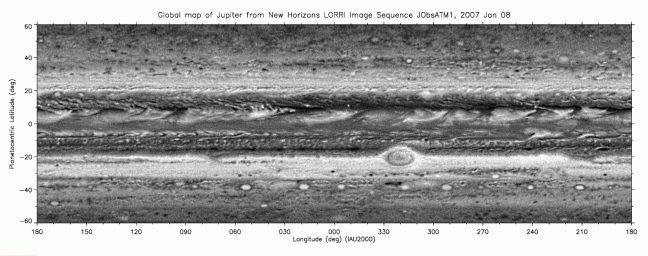
|
A ‘Moving’ Jupiter Global Map (Animation)
- Click the image above for a larger view
 Movie Download Options
Movie Download Options- Full-Res JPEG (1440 x 480) (137.0 kB)
- Full-Res TIFF (1440 x 480) (692.2 kB)
Caption:
The Long Range Reconnaissance Imager (LORRI) on New Horizons has acquired six global maps of Jupiter as the spacecraft approaches the giant planet for a close encounter at the end of February. The high-resolution camera acquired each of six observation "sets" as a series of individual pictures taken one hour apart, covering a full 10-hour rotation of Jupiter. The LORRI team at the Johns Hopkins University Applied Physics Laboratory (APL) reduced the sets to form six individual maps in a simple rectangular projection. These six maps were then combined to make the movie.
The table below shows the dates and the ranges from Jupiter at which these six sets of observations were acquired. Even for the latest set of images taken January 21-22, from 60.5 million kilometers (37.6 million miles), New Horizons was still farther from Jupiter than the average distance of Mercury from the Sun. At that distance from Jupiter, a single LORRI picture resolution element amounts to 300 kilometers (186 miles) on Jupiter.
Many features seen in Jupiter's atmosphere are giant storm clouds. The Little Red Spot, which LORRI will image close-up on February 27, is the target-like feature located near 30 degrees South and 230 degrees West; this storm is larger than the Earth. The even larger Great Red Spot is seen near 20 degrees South and 320 degrees West. The counterclockwise rotation of the clouds within the Great Red Spot can be seen. The westward drift of the Great Red Spot is easily seen in the movie, as is the slower drift, in the opposite direction, of the Little Red Spot. The storms of Jupiter are not fixed in location relative to each other or relative to any solid surface below, because Jupiter is a fluid planet without a solid surface.
Also, dramatic changes are seen in the series of bright plume-like clouds encircling the planet between 0 and 10 degrees North. Scientists believe these result from an enormous atmospheric wave with rising air, rich in ammonia that condenses to form the plume tails, and with falling air in the dark areas just to the east of each plume.
The maps of Jupiter shown here do not include the polar regions, because those regions are not well seen by LORRI from its vantage point high above Jupiter's equatorial region. Shadows of Jupiter's moons (first of Io, then of Ganymede) appear in two of the maps.
|
Cataloging Keywords:
| Name | Value | Additional Values |
|---|---|---|
| Target | Jupiter | Ganymede, Io |
| System | Jupiter | |
| Target Type | Planet | Satellite |
| Mission | New Horizons | |
| Instrument Host | New Horizons | |
| Host Type | Flyby Spacecraft | |
| Instrument | Long Range Reconnaissance Imager (LORRI) | |
| Detector | ||
| Extra Keywords | Ammonia, Atmosphere, Grayscale, Map, Movie, Plume, Rotation, Shadow, Storm, Visual | |
| Acquisition Date | ||
| Release Date | 2007-04-02 | |
| Date in Caption | 2007-01-15 | |
| Image Credit | NASA/Johns Hopkins University Applied Physics Laboratory/Southwest Research Institute | |
| Source | photojournal.jpl.nasa.gov/catalog/PIA09242 | |
| Identifier | PIA09242 | |
